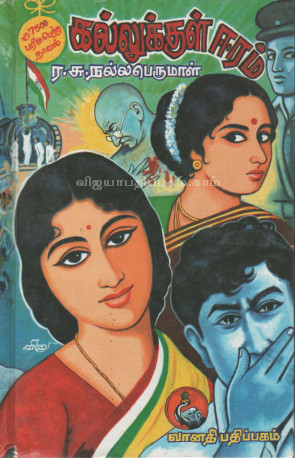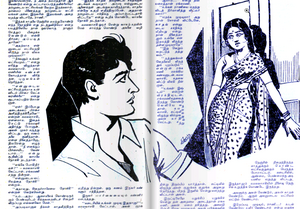Kallukul Eeram: Difference between revisions
(category & stage updated) |
(Added First published date) |
||
| (9 intermediate revisions by 3 users not shown) | |||
| Line 1: | Line 1: | ||
{{Read Tamil|Name of target page=கல்லுக்குள் ஈரம்|Title of target page=கல்லுக்குள் ஈரம்}} | {{Read Tamil|Name of target page=கல்லுக்குள் ஈரம்|Title of target page=கல்லுக்குள் ஈரம்}} | ||
[[File:Kallukkul.jpg|thumb| | [[File:Kallukkul.jpg|thumb|Kallukkul Eeram]] | ||
[[File:Kallukkuliiram1.png|thumb| | [[File:Kallukkuliiram1.png|thumb|Kallukkul Eeram - Kalki]] | ||
''Kallukkul Eeram'' is a novel written by | ''Kallukkul Eeram'' is a novel written by [[Ra.Su. Nallaperumal]]. It is written with Gandhi’s assassination as the backdrop; depicting the final stages of the Indian Independence Movement from a Gandhian’s perspective. | ||
== Writing, Publication == | == Writing, Publication == | ||
Ra.Su. Nallaperumal researched the history of Gandhi's assassination and used it as the backdrop for the novel. ''Kallukkul Eeram'' won the second prize in the Kalki Magazine Novel Competition in 1966. It was later published in 1969. | |||
Fourth edition of this novel came out in 1997. In the preface to this edition, the author expressed his sentiments as follows: | Fourth edition of this novel came out in 1997. In the preface to this edition, the author expressed his sentiments as follows: | ||
'Our revolution for independence, the revolutionaries, their determination and sacrifices inspired me to write this novel. The hopes and the enthusiasm with which I created this novel are withering now, considering our country’s decadence.’ | |||
this novel are withering now, considering our country’s decadence.’ | |||
== Synopsis == | == Synopsis == | ||
Rangamani, the protagonist, | Rangamani, the protagonist, witnesses his father beaten to death by the British for being a friend of V.O. Chidambaram Pillai. A family friend, named Dikshitar, takes him to Gandhiji to help him overcome his vengeful and violent attitude. Gandhi gives him a Cross as a gift which he treasures until his adulthood.Despite this, Rangamani remains stubborn to avenge his father’s death. He discontinues law school and joins an extremist group. Triveni, the daughter of the extremist group’s leader, is a stern believer of the Gandhian principle of Ahimsa. Rangamani has a change of heart after seeing Triveni’s sacrifice. At Triveni’s request, Rangamani goes to meet Gandhi and witnesses the assassination of Gandhi. The Cross he wore is bathed in Gandhi's blood as he attempts to hold him. | ||
== Controversies and Recognitions == | == Controversies and Recognitions == | ||
The leader of the Tamil Tigers, V. Prabhakaran named Kallukkul Eeram as one of his favourite books<ref>[https://frontline.thehindu.com/world-affairs/we-will-fight-for-our-political-objective-v-prabakaran/article6808332.ece We will fight for our political objective: V. Prabakaran, Frontline, September 1987]</ref>. The story of ''Hey Ram'' the Tamil movie written and directed by [[Kamal Haasan]] was regarded as almost the same as that of ''Kallukkul Eeram''. While the resemblance was coincidental, the filmmakers later obtained written permission from | The leader of the Tamil Tigers, V. Prabhakaran named Kallukkul Eeram as one of his favourite books<ref>[https://frontline.thehindu.com/world-affairs/we-will-fight-for-our-political-objective-v-prabakaran/article6808332.ece We will fight for our political objective: V. Prabakaran, Frontline, September 1987]</ref>. The story of ''Hey Ram'' the Tamil movie written and directed by [[Kamal Haasan]] was regarded as almost the same as that of ''Kallukkul Eeram''. While the resemblance was coincidental, the filmmakers later obtained written permission from Ra.Su. Nallaperumal. | ||
== Literary Significance == | |||
==Literary | Scepticism formed around the Gandhian movement in the 1950s led to the creation of works that had the common theme of "rediscovering Gandhi and Gandhian principles". Kallukkul Eeram has a similar theme. This novel creates an analogy between Gandhi’s blood being a liberating force like Jesus Christ’s blood. It also recognizes how Gandhi, a human being, was viewed as a divine power within twenty-five years of his demise. The story of Hey Ram, the movie released in 2000, resonates with the theme of Kallukkul Eeram; it depicts the same emotions and symbolic representations as Kallukul Eeram. | ||
Scepticism formed around the Gandhian movement in the 1950s | |||
== References == | == References == | ||
* [https://rengasubramani.blogspot.com/2021/05/blog-post_19.html Rangasubramani: Kallukkul Eeram - R.S. Nallaperumal] | * [https://rengasubramani.blogspot.com/2021/05/blog-post_19.html Rangasubramani: Kallukkul Eeram - R.S. Nallaperumal] | ||
* [https://vasagarkoodam.blogspot.com/2014/06/kallukkul-eeram.html Vasagar koodam: Kallukkul Eeram - R.S. Nallaperumal] | * [https://vasagarkoodam.blogspot.com/2014/06/kallukkul-eeram.html Vasagar koodam: Kallukkul Eeram - R.S. Nallaperumal] | ||
*[https://www.geotamil.com/index.php/2021-02-10-13-39-56/247-2011-06-30-01-12-52 Kallukkul Eeram - V.N. Giritharan] | *[https://www.geotamil.com/index.php/2021-02-10-13-39-56/247-2011-06-30-01-12-52 Kallukkul Eeram - V.N. Giritharan] | ||
== | == Footnotes == | ||
<references /> | <references /> | ||
{{Finalised-en}} | |||
{{Fndt-en|31-Oct-2022, 20:38:34 IST}} | |||
[[Category:English Content]] | [[Category:English Content]] | ||
Latest revision as of 14:07, 13 June 2024
இந்தப் பக்கத்தை தமிழில் வாசிக்க: கல்லுக்குள் ஈரம்
Kallukkul Eeram is a novel written by Ra.Su. Nallaperumal. It is written with Gandhi’s assassination as the backdrop; depicting the final stages of the Indian Independence Movement from a Gandhian’s perspective.
Writing, Publication
Ra.Su. Nallaperumal researched the history of Gandhi's assassination and used it as the backdrop for the novel. Kallukkul Eeram won the second prize in the Kalki Magazine Novel Competition in 1966. It was later published in 1969.
Fourth edition of this novel came out in 1997. In the preface to this edition, the author expressed his sentiments as follows:
'Our revolution for independence, the revolutionaries, their determination and sacrifices inspired me to write this novel. The hopes and the enthusiasm with which I created this novel are withering now, considering our country’s decadence.’
Synopsis
Rangamani, the protagonist, witnesses his father beaten to death by the British for being a friend of V.O. Chidambaram Pillai. A family friend, named Dikshitar, takes him to Gandhiji to help him overcome his vengeful and violent attitude. Gandhi gives him a Cross as a gift which he treasures until his adulthood.Despite this, Rangamani remains stubborn to avenge his father’s death. He discontinues law school and joins an extremist group. Triveni, the daughter of the extremist group’s leader, is a stern believer of the Gandhian principle of Ahimsa. Rangamani has a change of heart after seeing Triveni’s sacrifice. At Triveni’s request, Rangamani goes to meet Gandhi and witnesses the assassination of Gandhi. The Cross he wore is bathed in Gandhi's blood as he attempts to hold him.
Controversies and Recognitions
The leader of the Tamil Tigers, V. Prabhakaran named Kallukkul Eeram as one of his favourite books[1]. The story of Hey Ram the Tamil movie written and directed by Kamal Haasan was regarded as almost the same as that of Kallukkul Eeram. While the resemblance was coincidental, the filmmakers later obtained written permission from Ra.Su. Nallaperumal.
Literary Significance
Scepticism formed around the Gandhian movement in the 1950s led to the creation of works that had the common theme of "rediscovering Gandhi and Gandhian principles". Kallukkul Eeram has a similar theme. This novel creates an analogy between Gandhi’s blood being a liberating force like Jesus Christ’s blood. It also recognizes how Gandhi, a human being, was viewed as a divine power within twenty-five years of his demise. The story of Hey Ram, the movie released in 2000, resonates with the theme of Kallukkul Eeram; it depicts the same emotions and symbolic representations as Kallukul Eeram.
References
- Rangasubramani: Kallukkul Eeram - R.S. Nallaperumal
- Vasagar koodam: Kallukkul Eeram - R.S. Nallaperumal
- Kallukkul Eeram - V.N. Giritharan
Footnotes
✅Finalised Page
First published on:
31-Oct-2022, 20:38:34 IST


